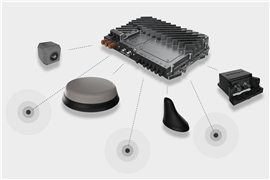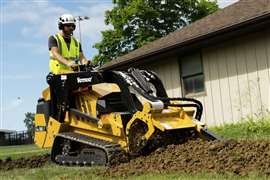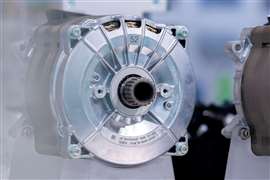Read this article in Français Deutsch Italiano Português Español
Autonomous robot aims to ease heavy lifting at solar farms
10 May 2025
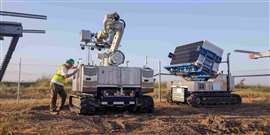 A worker programs instructions in the solar panel installation robot (left) while the photovoltaic (PV) module carrier (right) waits nearby. (Photo: Rosendin)
A worker programs instructions in the solar panel installation robot (left) while the photovoltaic (PV) module carrier (right) waits nearby. (Photo: Rosendin)
Building a solar farm is no easy task. Each photovoltaic (PV) solar module is so heavy to carry that it requires two people to do it. Technicians then have to lift them into place before making the necessary connections. It’s a process that installers must repeat all day at a site often consisting of dozens of acres of challenging terrain — and usually in scorching heat.
Electrical contracting company Rosendin helps build these solar farms. The company saw an opportunity to make installation of the PV modules faster, safer and less demanding for technicians. In partnership with robotics solutions company ULC Technologies, Rosendin developed an industry-first autonomous robot prototype that quite literally does all the heavy lifting.
David Lincoln, senior vice president for Rosendin in charge of the company’s renewable energy group, first came up with the idea in 2019 as a way to reduce physical strain on workers. The robot handles the heavy PV panels, allowing skilled electricians to focus on fastening the panels and making the critical electrical connections.
A Difficult Job
Lincoln described the rigorous manual installation process for PV modules that inspired the robot’s development. It starts with pallets of modules placed every 25 feet or so at the solar farm site, where they wait to be installed by a 10-person crew.
“The modules are 80 to 90 lb. right now,” Lincoln said. “You have to have two people pick up that module.”
The installers carry the modules over their heads. “And they walk on average 20 ft. with every module,” Lincoln added. They must place each module on the structure that supports it while other crew members make connections.
According to Lincoln, over the course of a workday, a crew will walk almost four miles carrying modules.
In a Rosendin video about the robot, Bill Mazzetti, Rosendin’s senior vice president for research & development, said of the installation process, “It’s not work that people can’t do, but it’s maybe work that people shouldn’t do.”
Designing the Robot
The solar panel installation robot is hybrid electric. A 30kW onboard diesel generator recharges the machine’s lithium iron magnesium phosphate (LiFeMgPO4) batteries as necessary for reliable runtime.
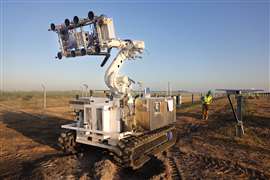 The robot can be driven manually via remote control if necessary. (Photo: Rosendin)
The robot can be driven manually via remote control if necessary. (Photo: Rosendin)
“When we first collaborated and went through the design aspects of what we wanted, originally we just had a basic diesel engine that could be readily serviced that was similar to the size of an engine that’s on a mini-excavator,” Lincoln said. “But as we got into it, there was [discussion] like, what if we just made it all-electric?”
Later talks about a fully electric robot focused on challenges in recharging, given how remote solar farm sites can be. Lincoln said the team decided to meet in the middle with a hybrid electric solution.
The machine features an integrated robotic arm having nine vacuum suction cups to lift and place the PV panels precisely.
“When I originally sketched the design of what I thought it would look like, it would be basically a mini-excavator that had a backhoe on it,” Lincoln said, adding that the idea was to remove the backhoe arm and replace it with a robotic arm that could grab and lift the PV modules.
The machine was also originally designed to be driven by an operator.
“But as we were going along through the design iterations, we found out that we could probably get rid of that manual aspect of an individual driving it and make it autonomous, which really opened everyone’s eyes,” Lincoln said.
ULC brought their expertise vis-à-vis an existing machine with a robotic arm used for another application, Lincoln said. As the companies worked together, the robot evolved into the current prototype.
Withstanding Harsh Environments
The autonomous machine was specifically designed for the rigors of solar farm installation.
“These large, utility-scale solar farms are being built really in the middle of nowhere,” Lincoln said. “They are remote, hot, rainy, dusty, windy, and sometimes you have hail.”
Being able to operate in those conditions while being easily serviceable was the guiding principle in developing the robot. For instance, one conscious choice was the use of tracks over wheels for locomotion.
“We quickly learned on these utility-scale solar farms that wheeled equipment does not work,” Lincoln said. “You have rain, mud, dust, so anything with a pneumatic wheel would not work. We knew it had to be track-mounted right out of the gate.”
Autonomous Operation
The robot is accompanied by two tracked module carriers that also operate autonomously. These take the place of the pallets of modules positioned at set intervals on the site.
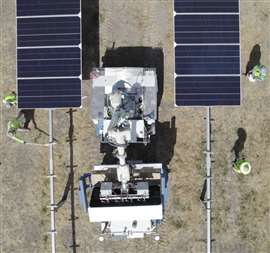 An overhead view of the robot picking up a PV module. The robot picks modules from autonomous module carriers that work with it. (Photo: Rosendin)
An overhead view of the robot picking up a PV module. The robot picks modules from autonomous module carriers that work with it. (Photo: Rosendin)
Lincoln explained that the robot moves down a row between racks intended to hold the PV modules. Two electricians are stationed on either side.
“As the robot picks up a module and sets it off to the left to that two-person team,” Lincoln said, “once it gets within 2-3 mm, the suction cups release. The electricians have it, and they set that panel in place.
“As they’re doing that, the robot arm goes back up, picks up another module and then goes off to the other side. That other two-person crew of electricians then takes it. By the time they’re done, the robot and its module carrier, which rides right next to it, they move up.”
Lincoln added that when one of the module carriers is empty, it autonomously returns to a location nearby where it can be refilled, after which it will return to the robot. While that is happening, the robot will pull modules from the second carrier.
The robot uses Lidar for obstacle detection and avoidance as part of its autonomous operation. The precise positioning of PV panels is made possible via GPS and KMZ mapping.
Safety, Other Benefits
Minimizing the amount of walking the crew does coupled with the elimination of heavy lifting has resulted in significant safety benefits.
“All the sprains and strains, the trip hazards, they’re all eliminated — virtually zero with the assistance of the robot helping set the module,” Lincoln said.
Additionally, it has freed up work crews for other assignments without having any negative effects on throughput.
According to Lincoln, a 10-person crew can manually install about 725 modules in an eight-hour workday.
“[The robot] has a five-person crew — four electricians and an operator that is just standing by,” he said. “They’re installing 600 modules in an eight-hour period, and that’s at 50 percent speed.”
Other benefits include a lack of waste.
“After we installed the modules, we took them off, and we sent them to [be] tested,” Lincoln said. “We sent it to three different test facilities, and those hundred-plus modules that we installed came back, and they were all still perfect. We had no microfractures, no nothing. So, we don’t void the warranty by picking up the modules [with] suction cups.”
The robot also avoids outright breaking of the modules.
“With the robot, it’s virtually zero, where manually, I can’t tell you how many modules we have that get broken,” he said.
Not Replacing Workers
For those in the industry who might worry that cutting the crew in half will result in lost jobs, Lincoln said that will not be the case, particularly given the chronic labor shortage in the solar farm industry.
“I have a 10-man crew, and now it takes five,” he said. “Those five individuals, I can put them on something more complicated that we need them on. So, we’re not taking away from the workforce. We’re diverting it to put them onto something else.”
According to Lincoln, the robot and its module carriers can be transported inside a 40-ft. container. In the future, such a container will also contain consumables and other maintenance items to address any operational issues. Multiple containers could be deployed to a site with each robot operating independently.
Seeking a Manufacturer
While the robots have been well received by installers — Lincoln said that they have been among the first to suggest improvements to the robot for more efficient operation — Rosendin is not an equipment maker. It has always been the company’s intent to find a partner to commercialize the robot.
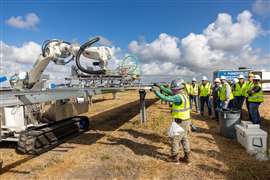 The robot hands off a PV panel to a worker. (Photo: Rosendin)
The robot hands off a PV panel to a worker. (Photo: Rosendin)
“We wanted to find a manufacturer that would take these, maybe value engineer them, go into revision two, make some other tweaks that we have in mind and produce these out there at a level that you could bring a bunch of these units to the renewable industry,” Lincoln said.
After demonstrating the robot, Lincoln said Rosendin has gotten a number of inquiries about purchasing the robots and the intellectual property with an eye for mass producing the robots. The most recent demo took place on April 17 at a large-scale solar project near Abilene, Texas, that is under construction.
“We’re not in the manufacturing business, but if somebody takes them from us, buys everything and produces them, we will either buy them or we will rent them back and use them for our own,” he added.
Rosendin recently announced it has begun taking offers to sell its autonomous robotic solution. The company said it will evaluate proposals through May based on manufacturing capabilities, market reach and a commitment to advancing renewable energy infrastructure.
The company said those interested in manufacturing and commercializing the robotic system can own it directly or use it as part of a rental fleet serving solar builders worldwide.
POWER SOURCING GUIDE
The trusted reference and buyer’s guide for 83 years
The original “desktop search engine,” guiding nearly 10,000 users in more than 90 countries it is the primary reference for specifications and details on all the components that go into engine systems.
Visit Now
STAY CONNECTED




Receive the information you need when you need it through our world-leading magazines, newsletters and daily briefings.
CONNECT WITH THE TEAM











